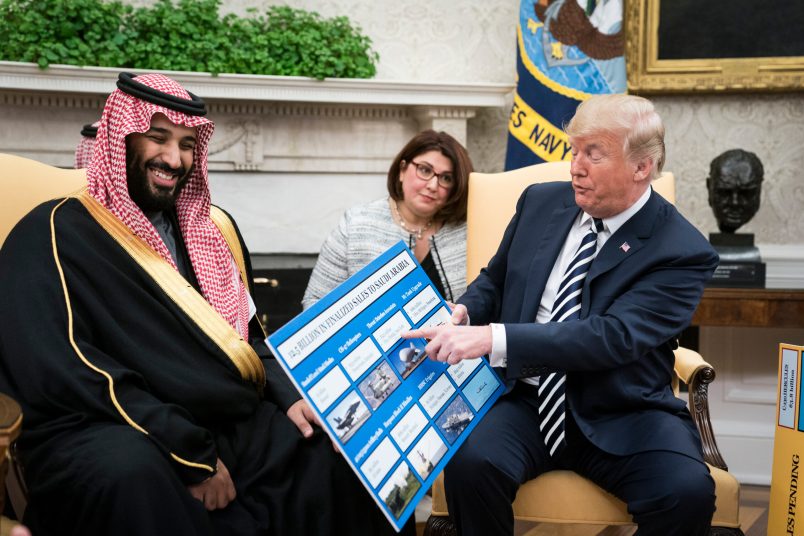President Donald Trump last week said that it “would not be acceptable” to “stop $110 billion from being spent in this country” as a result of Saudi journalist Jamal Khashoggi’s suspected murder by the Saudi government.
Trump was referring to what he initially celebrated as “a $110 billion Saudi-funded defense purchase” during a speech in Saudi Arabia last year. Then-White House press secretary Sean Spicer, a week later, on May 30, described “an immediate $110 billion investment, which will grow to $350 billion over the next 10 years.”
That’s not the case. On May 20, an unnamed White House official told reporters a much more revealing story about the $110 billion.
In short, the deal doesn’t really exist — yet.
The $110 billion sum, the administration official said, was made up of “Letters of Offer and Acceptance and future defense capabilities under development listed in a Memorandum of Intent to support Saudi Arabia’s defense needs.”
Think of that as two buckets: letters of offer and acceptance (LOAs), and a memorandum of intent (MOI). Neither represent concluded deals — far from an “immediate investment,” as Spicer claimed — and in any case, the $110 billion figure is inflated and takes credit for deals initiated during the Obama administration.
The Pentagon’s deal-making division, the Defense Security Cooperation Agency (DSCA), helpfully points out in its “Foreign Customer Guide” that an “LOA” represents a “government-to-government agreement that identifies the defense articles and services the USG proposes to sell to your country to meet the requirements identified in your [Letter of Request].” And memorandums of intent are just that: Intent, not reality.
Though LOAs represent dollars that are closer to being spent than MOIs, both buckets require congressional approval. And, as the Brookings Institution’s Bruce Riedel pointed out recently, “the kingdom has not bought any new arms platform during the Trump administration.”
In other words: Most of the deals Trump has refused to block in response to Khashoggi’s suspected murder are nascent proposals, at best, and many may never see the light of day.
For example: The Sept. 30 deadline for a THAAD anti-missile system sale, preliminarily approved by Congress, came and went without any Saudi commitment, “despite a 20 percent price cut,” the Washington Post reported. Jared Kushner reportedly negotiated that discount himself.
Shortly after Trump’s Saudi speech last year, DefenseNews broke down Trump’s claim into the two buckets based on a White House document it had obtained: “LOAs to be offered at visit” constituted $12.5 billion according to the document, it said, plus $1.18 billion in ten-year sustainment estimates.
The same document, per the report, counted $84.8 billion in “MOIs to be offered at visit” plus $930 million in sustainment estimates. The report made clear that the potential delivery dates for these weapons — and in fact, even the specific make and model of certain items — were yet to be determined.
Negotiations on the deals actually started during the Obama administration, which itself oversaw the sale of an astonishing amount of weaponry to the Saudis: A DSCA press release on Trump’s Saudi announcement described “Future sales outlined in the MOI” and “intended sales.” The same press release described $28 billion worth of Letters of Offer and Acceptance covered by Trump’s announcement, all of which Congress was actually notified about by the Obama administration, as the Washington Post pointed out.
The Associated Press and CNN, both citing Pentagon figures, reported last week that Saudi Arabia has only signed LOAs for $14.5 billion in purchases.
A Congressional Research Service report refers to the $110 billion figure as a “package of previously discussed and newly proposed defense sales,” and “completed and proposed defense sales.”
The report adds: “[I]n conjunction with President Trump’s May 2017 visit, Saudi authorities signed a series of Letters of Offer and Acceptance for sales proposed and notified to Congress by the Obama Administration and U.S. officials presented Memoranda of Intent regarding sales that have been informally discussed with congressional committees of jurisdiction or that the Administration intends to develop further in consultation with Saudi officials and then propose to Congress.”
The Washington Post poked more holes in the $110 billion number: Lockheed Martin and Boeing put out releases at the time of Trump’s announcement — detailing commercial as well as military purchases — “but other big-ticket items on the list [provided to the Post by the White House] have not been announced, and few if any contracts appear to have been signed.”
A Pentagon spokesperson told ABC News that the “arms sale announced between the U.S. and Saudi Arabia is a broad agreement in principle” and that “steps include letters of intent, letters of offer, letters of approval, awarding of contract, and delivery. As the terms of these sales are finalized, we will notify Congress and make public the specifics of each transaction.”
At the time of Trump’s announcement, House Minority Whip Steny Hoyer (D-MD) said in a statement that “The Administration failed to brief Congress on any of the details of this deal while it was in the works.”







But there is a 1 Billion deal where they bailed out Jared Kushner.
Mr. Mueller, for love of FSM…
So, Fat Nixon will of course recant and apologize for the bald-faced, sycophantic lying in… 5… 4… 3…
If only Trump … didn’t actually exist.
Then we’d be getting somewhere.
The schmuck lives in fantasy land …
In the 60 minutes interview … he mentioned ’ trillions and trillions ’ —
reality twisted …mind broken … narcissistic balloon —